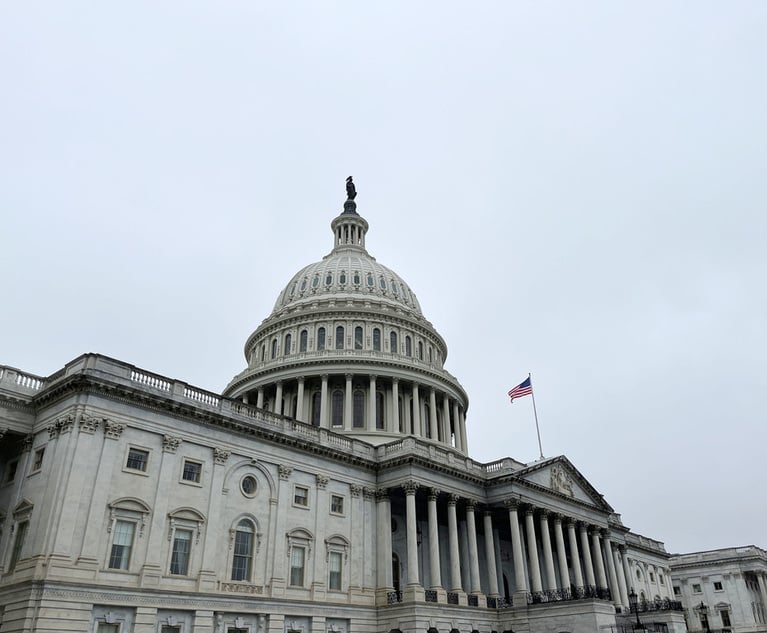Law Firm Merger Market Stayed Sluggish in Q3
In spite of the absence of blockbuster mergers thus far in 2019, large firms haven't abandoned discussions, according to consultancy Fairfax Associates.
September 30, 2019 at 12:40 PM
4 minute read
 Image: Shutterstock
Image: Shutterstock
Law firm mergers continued to lag behind 2018′s record-shattering pace, according to the latest data collected by consultancy Fairfax Associates.
Fairfax found just 16 completed mergers during the third quarter of 2019 and a total of 46 over the course of the year, down from the 57 completed through the first three quarters of 2018. Furthermore, blockbuster mergers have been absent from the scene, a point illustrated by the collapse of talks between Allen & Overy and O'Melveny & Myers in the middle of the quarter. Eighty percent of the 16 mergers were in the five-to-25-lawyer range.
Nonetheless, Fairfax analyst Lisa Smith said that there was no shortage of merger discussions between larger firms.
"It's surprising this year that we haven't seen the big mergers we have seen in the past," adding that she wouldn't rule out more significant combinations slated for Jan. 1, 2020, or beyond.
In spite of the dip from last year, the 46 mergers completed thus far is actually ahead of the historic average of 43 mergers through the first three quarters, based on data over the last 10 years.
Just two of the 16 mergers completed in the third quarter crossed national borders. Greenberg Traurig picked up 37 lawyers from its longstanding ally in Milan, Santa Maria Studio Legale, in one of the three largest deals of the quarter. As Dentons continues to bolt on existing firms around the world, it finalized a six-lawyer combination in Honduras with Gustavo Zacapa y Asociados, amid 10 other pending cross-border mergers.
That and two other international tie-ups earlier in the year mean that Dentons is responsible for 43% of the total number of cross-border mergers.
The largest merger in the quarter was a domestic one, where Seattle's Foster Pepper and Garvey Schubert Barer combined to create a new firm called Foster Garvey with approximately 200 lawyers.
Smith noted that in certain markets subject to increasing competition from national players, existing firms are feeling the pinch and looking to mergers to stay afloat.
"Where there's been a lot of consolidation in a market, smaller and midsized firms have a little more trouble competing," she said, pointing to Dallas as one example. There, SettlePou combined with The Berry Firm in the second quarter, one of two combinations in Texas. The other, in Houston, saw Spencer Fane combine with Zimmerman Axelrad Stern & Wise.
Other states home to multiple mergers in the quarter were California and Washington state, along with Washington, D.C., all with two.
Smith also flagged Minneapolis, Chicago and Boston as markets that have recently seen an incursion of outsiders, keeping the pressure on midsized firms. Elsewhere, midsized firms may be perfectly fine competing locally, even if they may struggle to compete regionally and nationally.
The other exception to this pressure, also recently identified by consultant Brad Hildebrandt, are specialty and boutique firms.
"Two hundred to 300 attorneys might be a perfectly viable and competitive platform," Smith said. "Size isn't as much of a factor as depth of practice and what they're known for."
Smith does not believe that growing doubts about the longevity of the current economic expansion, now the longest in history, are contributing to the slowing pace of mergers.
"It's not a front-and-center issue that impacts expansion," she said. "If anything, it pushes firms to think of having a broader, more diversified platform that would be better in the event of a contraction."
Read More
This content has been archived. It is available through our partners, LexisNexis® and Bloomberg Law.
To view this content, please continue to their sites.
Not a Lexis Subscriber?
Subscribe Now
Not a Bloomberg Law Subscriber?
Subscribe Now
NOT FOR REPRINT
© 2025 ALM Global, LLC, All Rights Reserved. Request academic re-use from www.copyright.com. All other uses, submit a request to [email protected]. For more information visit Asset & Logo Licensing.
You Might Like
View All
'Ridiculously Busy': Several Law Firms Position Themselves as Go-To Experts on Trump’s Executive Orders
5 minute read
Holland & Knight Hires Former Davis Wright Tremaine Managing Partner in Seattle
3 minute read
Am Law 200 Firms Announce Wave of D.C. Hires in White-Collar, Antitrust, Litigation Practices
3 minute read
Paul Hastings Hires Music Industry Practice Chair From Willkie in Los Angeles
Trending Stories
- 15th Circuit Considers Challenge to Louisiana's Ten Commandments Law
- 2Crocs Accused of Padding Revenue With Channel-Stuffing HEYDUDE Shoes
- 3E-discovery Practitioners Are Racing to Adapt to Social Media’s Evolving Landscape
- 4The Law Firm Disrupted: For Office Policies, Big Law Has Its Ear to the Market, Not to Trump
- 5FTC Finalizes Child Online Privacy Rule Updates, But Ferguson Eyes Further Changes
Who Got The Work
J. Brugh Lower of Gibbons has entered an appearance for industrial equipment supplier Devco Corporation in a pending trademark infringement lawsuit. The suit, accusing the defendant of selling knock-off Graco products, was filed Dec. 18 in New Jersey District Court by Rivkin Radler on behalf of Graco Inc. and Graco Minnesota. The case, assigned to U.S. District Judge Zahid N. Quraishi, is 3:24-cv-11294, Graco Inc. et al v. Devco Corporation.
Who Got The Work
Rebecca Maller-Stein and Kent A. Yalowitz of Arnold & Porter Kaye Scholer have entered their appearances for Hanaco Venture Capital and its executives, Lior Prosor and David Frankel, in a pending securities lawsuit. The action, filed on Dec. 24 in New York Southern District Court by Zell, Aron & Co. on behalf of Goldeneye Advisors, accuses the defendants of negligently and fraudulently managing the plaintiff's $1 million investment. The case, assigned to U.S. District Judge Vernon S. Broderick, is 1:24-cv-09918, Goldeneye Advisors, LLC v. Hanaco Venture Capital, Ltd. et al.
Who Got The Work
Attorneys from A&O Shearman has stepped in as defense counsel for Toronto-Dominion Bank and other defendants in a pending securities class action. The suit, filed Dec. 11 in New York Southern District Court by Bleichmar Fonti & Auld, accuses the defendants of concealing the bank's 'pervasive' deficiencies in regards to its compliance with the Bank Secrecy Act and the quality of its anti-money laundering controls. The case, assigned to U.S. District Judge Arun Subramanian, is 1:24-cv-09445, Gonzalez v. The Toronto-Dominion Bank et al.
Who Got The Work
Crown Castle International, a Pennsylvania company providing shared communications infrastructure, has turned to Luke D. Wolf of Gordon Rees Scully Mansukhani to fend off a pending breach-of-contract lawsuit. The court action, filed Nov. 25 in Michigan Eastern District Court by Hooper Hathaway PC on behalf of The Town Residences LLC, accuses Crown Castle of failing to transfer approximately $30,000 in utility payments from T-Mobile in breach of a roof-top lease and assignment agreement. The case, assigned to U.S. District Judge Susan K. Declercq, is 2:24-cv-13131, The Town Residences LLC v. T-Mobile US, Inc. et al.
Who Got The Work
Wilfred P. Coronato and Daniel M. Schwartz of McCarter & English have stepped in as defense counsel to Electrolux Home Products Inc. in a pending product liability lawsuit. The court action, filed Nov. 26 in New York Eastern District Court by Poulos Lopiccolo PC and Nagel Rice LLP on behalf of David Stern, alleges that the defendant's refrigerators’ drawers and shelving repeatedly break and fall apart within months after purchase. The case, assigned to U.S. District Judge Joan M. Azrack, is 2:24-cv-08204, Stern v. Electrolux Home Products, Inc.
Featured Firms
Law Offices of Gary Martin Hays & Associates, P.C.
(470) 294-1674
Law Offices of Mark E. Salomone
(857) 444-6468
Smith & Hassler
(713) 739-1250










